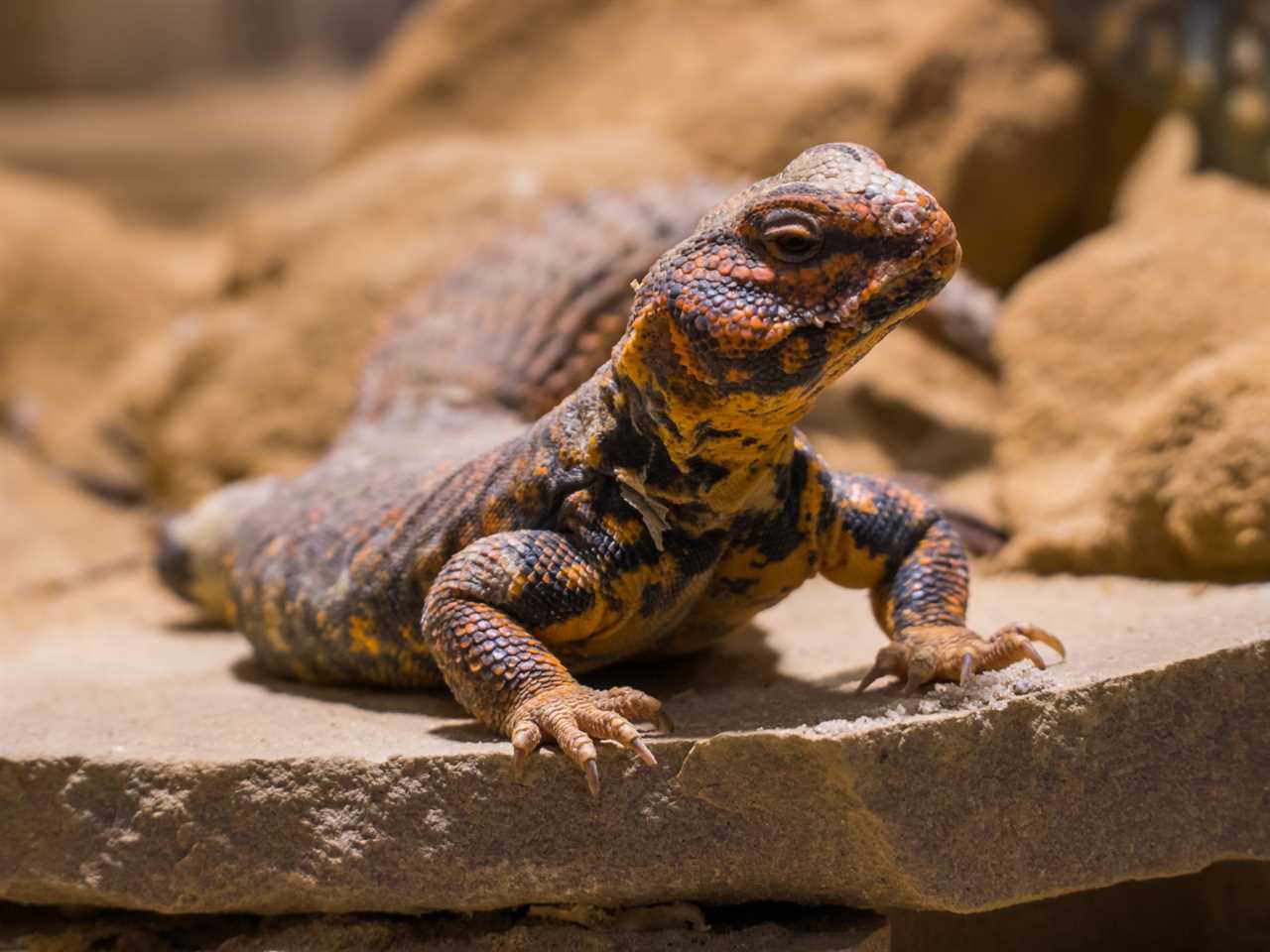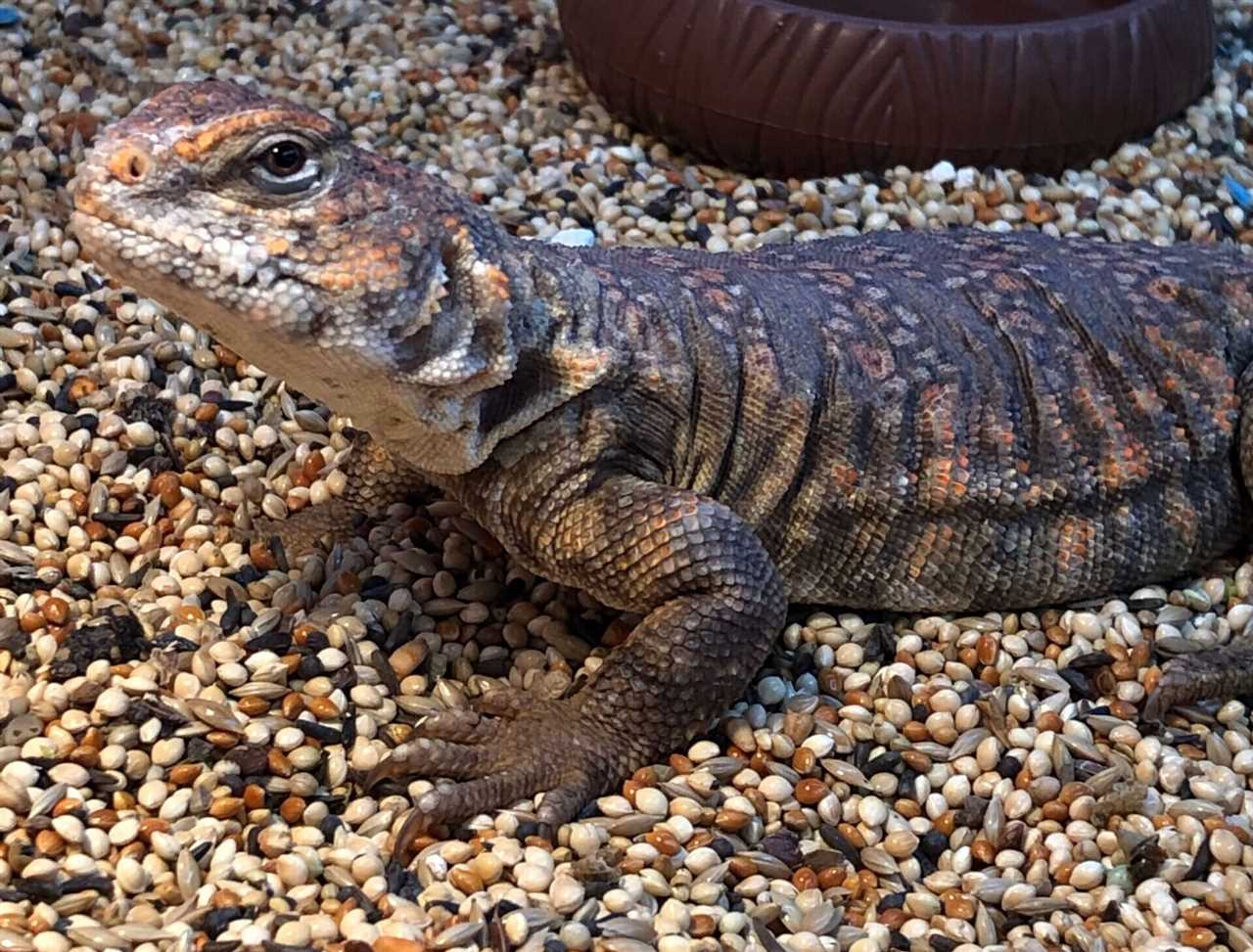
Proper temperature and lighting are crucial for the well-being of uromastyx. These reptiles require a basking spot with temperatures ranging from 100 to 120 degrees Fahrenheit (37-49 degrees Celsius) and a cooler side of the enclosure that maintains a temperature of around 80 to 90 degrees Fahrenheit (27-32 degrees Celsius). UVB lighting is also essential for their calcium metabolism and overall health.
What is a pet uromastyx?
Uromastyx lizards come in a variety of species, each with its own unique characteristics and requirements. While some species grow to a size of 10 to 14 inches, others can grow up to 24 inches in length. Their colors and patterns vary as well, with some species displaying bright oranges, yellows, and greens, while others have more muted tones.
One of the most fascinating aspects of pet uromastyx is their ability to store fat in their tails and bodies. During times of scarcity, they can utilize these fat stores to survive. This adaptation allows them to endure long periods without food and water, making them well-suited to the harsh desert environments where they are typically found in the wild.
Choosing the Right Uromastyx
Additionally, it’s a good idea to choose a uromastyx that has been captive-bred rather than wild-caught. Captive-bred uromastyx tend to be healthier and more acclimated to living in captivity. They are also less likely to carry diseases or parasites.
Uromastyx enclosure setup for pet uromastyx
Creating the right enclosure setup is essential for the health and well-being of your pet uromastyx. Uromastyx are desert-dwelling reptiles, and they require a warm and dry environment that mimics their natural habitat.
Enclosure size
Substrate
The substrate you choose should be safe and easily cleaned. You can use a combination of play sand, reptile carpet, or paper towels. Avoid using substrates that can cause impaction, such as loose particles or wood chips.
Temperature gradient
Lighting
Uromastyx need access to UVB lighting in their enclosure. UVB helps them synthesize vitamin D3 and aids in calcium absorption, which is essential for their bone health. Use a UVB lamp specifically designed for reptiles and follow the recommended distance and duration guidelines provided by the manufacturer.
Hide spots
Provide numerous hide spots throughout the enclosure. Uromastyx are shy creatures by nature and need places to retreat and feel secure. You can use rocks, logs, or commercially available reptile hides to create suitable hiding spots.
By setting up the enclosure properly, you’ll be providing your pet uromastyx with a comfortable and stress-free environment that resembles their natural habitat. Regularly monitor the temperature, humidity, and cleanliness of the enclosure to ensure the health and well-being of your pet.
Temperature and humidity requirements
Proper temperature and humidity levels are crucial for the health and well-being of your pet uromastyx. Uromastyx are desert-dwelling reptiles and require a hot and dry environment to thrive.
The ideal temperature range for a uromastyx enclosure is between 90 to 100 degrees Fahrenheit (32 to 38 degrees Celsius) during the day, with a slight drop to 70 to 80 degrees Fahrenheit (21 to 27 degrees Celsius) at night. This temperature gradient allows your uromastyx to thermoregulate and bask under the heat source.
It is essential to provide a proper heat source for your uromastyx. One option is to use a heat lamp or ceramic heat emitter placed at one end of the enclosure to create a basking spot with temperatures reaching the upper end of the range. You can also use heating pads or heat rocks, but make sure they are controlled by thermostats to prevent overheating.
In addition to temperature, maintaining the right humidity level is equally important. Uromastyx require a low humidity environment, ideally around 20 to 30 percent. Higher humidity levels can lead to respiratory problems and other health issues.
It is essential to monitor the temperature and humidity levels regularly using thermometers and hygrometers placed at different locations in the enclosure. This ensures that the conditions are within the appropriate range at all times.
Providing your pet uromastyx with the correct temperature and humidity levels replicates their natural habitat and promotes their overall health and well-being.
Diet and Nutrition
What to Feed
Uromastyx should be fed a wide range of leafy greens, vegetables, and some fruits. Some examples of suitable greens include collard greens, dandelion greens, kale, and mustard greens. Vegetables like bell peppers, squash, and pumpkin can also be offered. Fruits such as berries and melon can be given as an occasional treat.
Supplements
Feeding Schedule

Handling and Taming
Start by allowing your uromastyx to acclimate to its new enclosure for a few days without handling. This will help reduce stress and allow the uromastyx to settle into its new environment. Once it seems relaxed and comfortable, you can begin the taming process.
Always approach your pet uromastyx slowly and calmly. Avoid sudden movements or loud noises that can startle it. Place your hand in the enclosure and allow the uromastyx to approach you on its own terms. Let it sniff and investigate your hand before attempting to touch it.
When you do start handling your uromastyx, make sure to support its body properly. Uromastyx have sensitive tails that can easily be injured if not handled correctly. Gently scoop the uromastyx up with both hands, supporting its body and tail, and avoid squeezing or gripping it too tightly.
Overall, with time, patience, and gentle handling, you can develop a bond with your pet uromastyx and provide it with a positive and enriching experience.
Common health issues and care
Ensuring the health and well-being of your uromastyx is essential for their overall happiness. Like any pet, uromastyx can experience certain health issues that require attention and care.
Common health issues:
- Digestive problems: Uromastyx may experience digestive issues such as constipation or diarrhea. These issues can often be caused by an improper diet or inadequate temperature and humidity levels in their enclosure.
- Respiratory infections: Uromastyx can develop respiratory infections, especially if they are exposed to cold temperatures or drafts. Symptoms may include wheezing, coughing, and difficulty breathing.
- Metabolic bone disease: This is a common health issue in uromastyx due to a deficiency of calcium and Vitamin D3. It can lead to deformities in the bones and shell, as well as a weakened immune system.
- Dehydration: Uromastyx need to have access to fresh water at all times to prevent dehydration. Lack of water can lead to serious health complications.
Caring for your uromastyx:
To ensure the health and well-being of your uromastyx, follow these care guidelines:
- Provide a suitable enclosure: Create an environment that mimics the natural habitat of uromastyx, including a proper substrate, basking area, hiding spots, and appropriate lighting.
- Maintain proper temperature and humidity levels: It’s crucial to maintain the correct temperature and humidity levels according to the specific needs of your uromastyx species. Use thermometers and hygrometers to monitor these levels.
- Feed a balanced diet: Uromastyx are herbivores and require a diet rich in leafy greens, vegetables, and occasional fruits. Avoid feeding them animal protein or high-fat foods, as it can lead to health issues.
- Provide fresh water: Ensure that your uromastyx always has access to clean, fresh water. This will help prevent dehydration and promote healthy digestion.
- Regular veterinarian check-ups: Schedule regular check-ups with a reptile veterinarian who has experience with uromastyx. They can provide necessary vaccinations and check for any potential health issues.
- Monitor behavior and appearance: Keep an eye on your uromastyx’s behavior and appearance for any abnormal signs. This includes changes in appetite, weight loss, lethargy, or skin abnormalities. Seek veterinary care if you notice any concerning symptoms.
By following these guidelines and providing proper care, you can help ensure that your uromastyx stays healthy and happy for years to come.
Reproduction and Breeding of Uromastyx
Mating season for uromastyx typically occurs during the spring and summer months. During this time, males will engage in courtship behaviors to attract females. These behaviors may include head bobbing, tail wagging, and displaying vibrant colors. If a female is receptive, she will allow the male to approach and mate with her.
After mating, the female uromastyx will dig a burrow in the sand or soil to lay her eggs. The number of eggs can vary depending on the species, with some uromastyx species laying as few as 2-6 eggs and others laying up to 15 or more. The eggs are typically laid in a chamber at the end of the burrow, where the female will provide protection and regulate the temperature and humidity levels.
Egg Incubation
Hatching and Care of Hatchlings
It is also important to note that baby uromastyx may require more frequent feedings compared to adults. They should be provided with food multiple times a day to support their growth and development. Regular monitoring of their health and well-being is essential during this delicate stage.
Overall, the reproduction and breeding of uromastyx can be a fascinating and rewarding experience. By providing the proper conditions and care, uromastyx owners can witness the beauty of new life and contribute to the conservation of these amazing reptiles.
Uromastyx Species and Variations
Uromastyx is a genus of reptiles belonging to the Agamidae family. There are several species and variations within the Uromastyx genus, each with its own unique characteristics and care requirements. Here are some of the most popular Uromastyx species:
1. Uromastyx ornata
2. Uromastyx aegyptia
The Egyptian Uromastyx, as its name suggests, is found in Egypt and other parts of North Africa. It is characterized by its vibrant yellow color and distinctive spiky tail. This species requires a warm and arid habitat to thrive.
3. Uromastyx geyri
The Saharan Uromastyx, or Uromastyx geyri, is native to the Sahara Desert in North Africa. It has a unique blend of colors, including shades of yellow, orange, and red. This species requires a large enclosure with plenty of hiding spots and basking areas.
4. Uromastyx ocellata
5. Uromastyx thomasi
The Thomas’ Uromastyx is native to Sudan and Chad. It has a robust build and is known for its strong digging abilities. This species is highly active and requires a spacious enclosure with areas for climbing and burrowing.
These are just a few examples of the different Uromastyx species available in the pet trade. Each species has its own specific care requirements, so it’s essential to research and understand the needs of the species you choose to keep as a pet.

I’m Lena Adams—a product of an unconventional upbringing in the African wilderness. My father, a daring explorer of African wildlife, sparked my fascination with reptiles, a passion that intertwined with the tragic loss of my mother during an expedition, leaving an indelible mark on my life. Driven to understand the creatures that captivated my parents, I embarked on my journey, sharing insights about reptiles, frogs, and lizards on my website. Through my explorations and conservation efforts, I honour my family’s legacy while seeking connections—to the creatures, nature, and the mother whose presence I yearn to understand.
